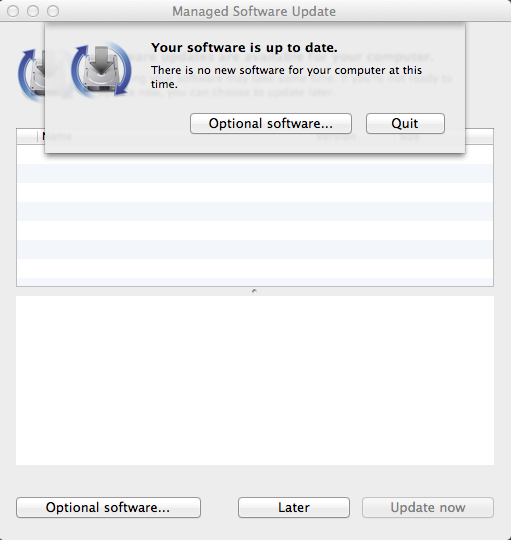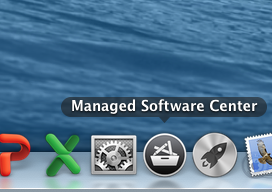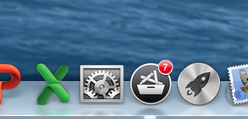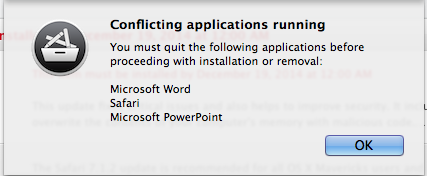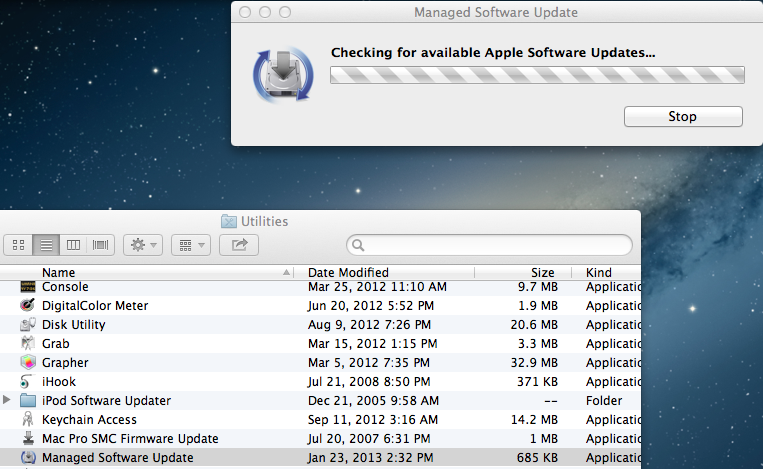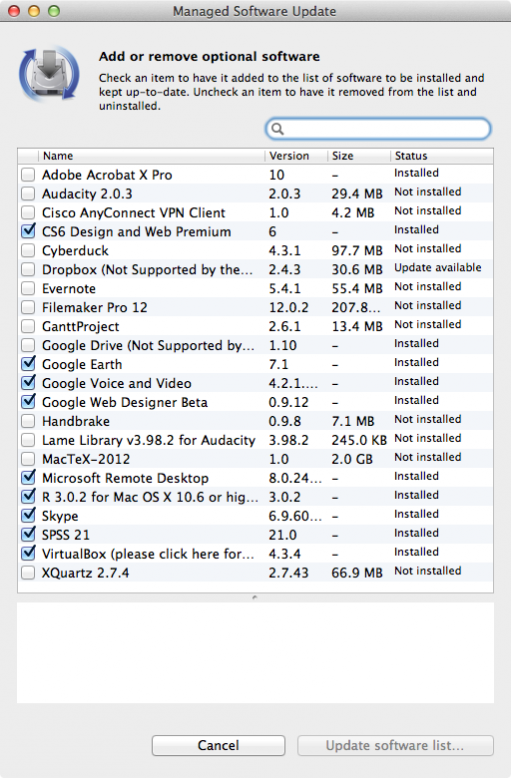Mac OS Managed Software Center
About
William Paterson University uses a program called Managed Software Center to maintain the university supplied software installed on university supplied Mac OS machines. The Managed Software Center runs a periodic check for available updates (every 2 days). The software may be manually run by the user or a tech and does NOT require administrative permissions to run.
Managed Software Center resides in the Applications folder and can be run at any time the user wishes to check for updates so long as they are connected to the university network (ethernet, wireless or VPN):
Dock Icons
Computers managed by IT will have a Dock icon for Managed Software Center (MSC).
MSC runs a check for updates in the background. If it finds any, it will post a notification on the Dock icon with the number of pending updates.
Running The Application
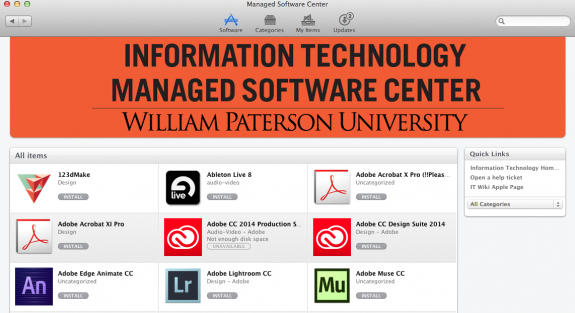
This is the main Managed Software Center screen. *not all software pictured may be available to you.*
If you Managed Software Center (MSC) you are usually greeted with this screen. MSC will show you all available software for installation. An item may be disabled based on your hardware (example: the Adobe CC Production Suite cannot be installed because I have too little space left on my hard drive).
On the right side are Quick Links. You can use any of the links there to go to:
1) The IT home page.
2) The Helpdesk ticketing system.
3) The IT Wiki page for Mac OS information.
For your convenience these links will open within the MSC application rather than a browser and will work while off campus like any browser link.
Installing Applications
If you see an Application you wish to install just click on it. In this example Audacity is requested.
The audacity installer has been downloaded and is ready to install. Go to the updates window to complete the install.
Removing Applications
Removing software is as easy as installing it.
Once we click on any of the removal buttons MSC will initiate it's software removal process. It will notify you that the application "Will be removed." You should go to the Updates window to complete the uninstall.
When you see a little "x" next to an update item this means that you can cancel that particular update. This does not show up for all items.
The Managed Software Center Updates Window
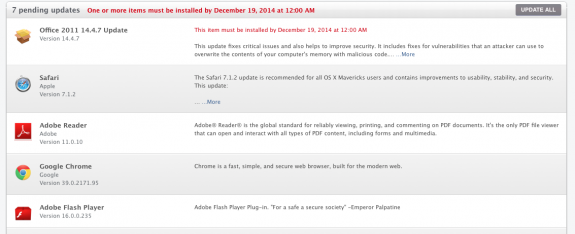
This is the main Managed Software Center screen. *not all software pictured may be available to you.*
On some occasions you will open MSC and it will default to the updates screen and you will see a list of 1 or more items that are available for install.
Note the message in red at the top of the screen. This message will inform you that one or more updates have an "install by" date and time. The update(s) that have due dates will also show their install by information in their line item. DO NOT ignore this warning. You may safely postpone these updates by closing the application. However, once the due date has arrived your computer will begin a countdown (usually 30 minutes) to do those installs.
Non security items are usually set to install 2 weeks after they have originally been posted. You will be notified at least 4 times prior to forced install in that time. If you have been out on leave and your computer has not been used for an extended period of time, it is STRONGLY suggested that you run MSC before starting any work.
Security related items may have a very short "install by" window per university computer policies. It is strongly suggested that if a security update install appears to install that software ASAP.
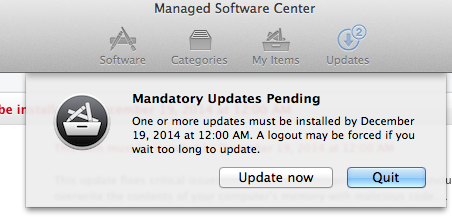
This is a warning for a pending mandatory update. Please heed this warning. Your machine will likely log you out and do the update within the next 30 minutes.
Some updates require certain applications to be quit before they will run. In such cases you will be notified of which applications need to be quit. If you have an update that has to be installed by a certain date and you are constantly running a conflicting application (usually the Office suite or a Browser) this can become an issue. Please schedule some time to have the conflicting applications all quit before the pending install by date.
To run the pending updates just click on the "Update All" button.
About (This is for the original software. Disregard after Jan 5 2015)
William Paterson University uses a program called Managed Software update to maintain the university supplied software installed on university supplied Mac OS machines. The Managed Software Update runs a periodic check for available updates. The software may be manually run by the user or a tech and does NOT require administrative permissions to run.
Managed Software Update resides in the /Applications/Utilities folder and can be run at any time the user wishes to check for updates so long as they are connected to the university network (ethernet, wireless or VPN):
When Managed Update is run it will check against the central server for a list of available updates. It will also check the APPLE SUS for Apple supplied updates. When it finds updates it downloads the package installers. By IT default Managed Software Update will notify the user once every 5 days:
A message will appear listing the available updates, in this case the Office 2011 14.3.1 update :
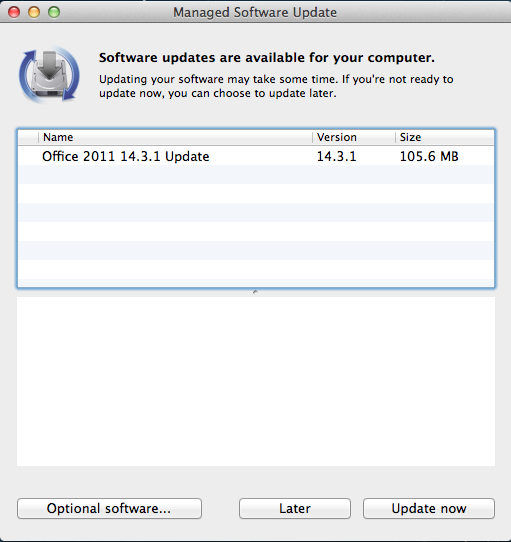
Users can opt to do the update later if they are busy. Eventually installs will not wait.
Below we see that 4 items are flagged for install. Certain items will have an “install by” date and if the user has not done the install. Newly imaged machines will have all items flagged.
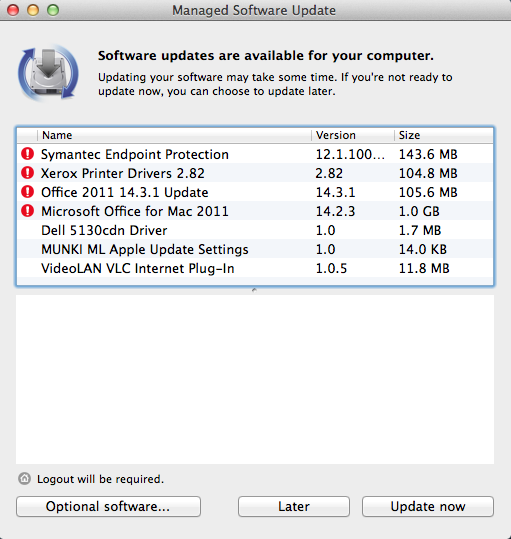
Users can install with or without a logout depending on the item(s) to be installed. Some items require a logout.
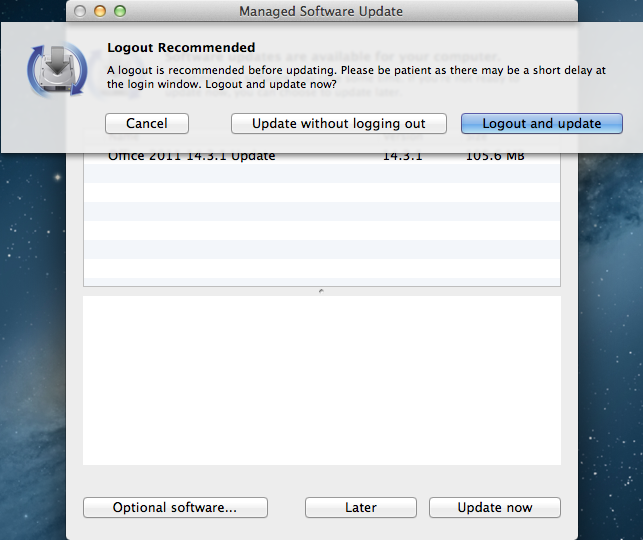
Eventually Managed Update will get aggressive with updates and display a message similar to the one below. Note the warning about saving work.:
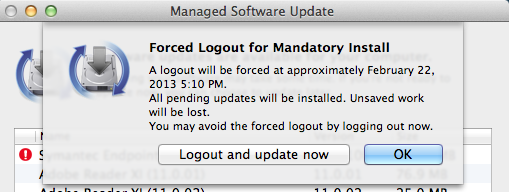
If you have gotten the above warning do NOT ignore it. The machine will log you off regardless of what you are doing. If you are teaching a class it will happen while you are teaching. If you are working on a file, it will quit the program you are using. Do not ignore these warnings. We do our best to not mark items with "install by" dates. When such an item is marked it is an item that is extremely important. Do not take the warning lightly.
Optional Software
There are certain items that are optional installs for all faculty and staff, click for a list of Current Optional Software For Mac . They may install these items at will. They may select these by selecting the "optional software" button. Note that some items carry a disclaimer.
